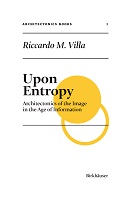Upon Entropy
Architectonics of the Image in the Age of Information
| dc.contributor.author | Villa, Riccardo M. | |
| dc.contributor.editor | Hovestadt, Ludger | |
| dc.contributor.editor | Bühlmann, Vera | |
| dc.date.accessioned | 2024-02-27T13:52:17Z | |
| dc.date.available | 2024-02-27T13:52:17Z | |
| dc.date.issued | 2024 | |
| dc.identifier.uri | https://library.oapen.org/handle/20.500.12657/88037 | |
| dc.description.abstract | In his 1979 essay The Postmodern Condition: A Report on Knowledge philosopher Jean-François Lyotard noted that the advent of the computer opened up a stage of progress in which knowledge has become a commodity. Modernity and postmodernity appear as two stages of a process resulting from the conflict of science and narrative. As science attempts to distance itself from narrative, it must create its own legitimacy. This paper takes up this challenge with a focus on the question of imagery. The image is precisely what modern science seeks to free itself from in its quest for absolute transparency. This transparency is examined from the perspective of architecture, drawing on arguments from philosophy, quantum mechanics, theology and information theory. Natural science in the context of postmodernism Quantum mechanics and information theory New volume in the Applied Virtuality Book Series ; In his 1979 essay The Postmodern Condition: A Report on Knowledge philosopher Jean-François Lyotard noted that the advent of the computer opened up a stage of progress in which knowledge has become a commodity. Modernity and postmodernity appear as two stages of a process resulting from the conflict of science and narrative. As science attempts to distance itself from narrative, it must create its own legitimacy. This paper takes up this challenge with a focus on the question of imagery. The image is precisely what modern science seeks to free itself from in its quest for absolute transparency. This transparency is examined from the perspective of architecture, drawing on arguments from philosophy, quantum mechanics, theology and information theory. Natural science in the context of postmodernism Quantum mechanics and information theory New volume in the Applied Virtuality Book Series | en_US |
| dc.language | English | en_US |
| dc.relation.ispartofseries | Applied Virtuality Book Series | en_US |
| dc.subject.classification | thema EDItEUR::A The Arts::AM Architecture::AMA Theory of architecture | en_US |
| dc.subject.other | Kommunikation;Design;Architektur;Natur;Naturwissenschaft;Architekturtheorie;Informatik;Postmoderne;Digitale Technologie;Quantenmechanik;Informationstheorie;Communication;Nature;Natural science;Architecture theory;Computer Science;Postmodernism;Digital Technology;Quantum Mechanics;Information Theory | en_US |
| dc.title | Upon Entropy | en_US |
| dc.title.alternative | Architectonics of the Image in the Age of Information | en_US |
| dc.type | book | |
| oapen.abstract.otherlanguage | Naturwissenschaft im Zeichen der Postmoderne Quantenmechanik und Informationstheorie Neuer Band der Reihe Applied Virtuality Book Series In seinem 1979 erschienenen Essay Das postmoderne Wissen stellte Jean-François Lyotard fest, dass die Einführung des Computers ein Stadium des Fortschritts definiert, in dem Wissen zur Ware wird. Moderne und Postmoderne erscheinen als zwei Stadien eines Prozesses, der aus dem Konflikt der Wissenschaft mit den Narrativen resultiert: Während die Wissenschaft versucht, sich vom Narrativen zu distanzieren, muss sie ihre eigene Legitimation schaffen. Die vorliegende Abhandlung greift die Herausforderung im Zeichen des Bildes auf. Das Bild ist genau das, wovon sich die moderne Wissenschaft auf der Suche nach absoluter Transparenz zu befreien versucht. Diese Transparenz wird unter architektonischen Gesichtspunkten untersucht, die von der Philosophie bis zur Quantenmechanik, von der Theologie bis zur Informationstheorie reichen. | |
| oapen.relation.isPublishedBy | 2b386f62-fc18-4108-bcf1-ade3ed4cf2f3 | en_US |
| oapen.relation.isbn | 9783035627671 | en_US |
| oapen.imprint | Birkhäuser | en_US |
| oapen.series.number | 23 | en_US |
| oapen.pages | 256 | en_US |

